
94% of researchers rate our articles as excellent or good
Learn more about the work of our research integrity team to safeguard the quality of each article we publish.
Find out more
ORIGINAL RESEARCH article
Front. Nanotechnol. , 15 August 2023
Sec. Nanomaterials
Volume 5 - 2023 | https://doi.org/10.3389/fnano.2023.1213160
This article is part of the Research Topic Opportunities and Challenges for Nanotechnology in Sustainable Agri-Food Production View all 5 articles
Global food production consumes a large fraction of energy budget, land area, and freshwater; however, a larger fraction of the produce is lost or unutilized, which has potential to produce useful products for human use. The biogenic synthesis of silver nanoparticles from such waste food appears to be a promising strategy. A conservative estimate of 70–140 thousand tons of potato peels is produced annually by food-chain companies globally; however, they are primarily utilized to produce substandard feed for livestock or manure. For the formation of highly profitable compounds, enhancement of value, and the process of extraction, such as nanocomposite, organic antioxidants, and organic meal inclusions, potato peels can be used as a cheap, productive, and readily available source of raw material. In the present research, silver nanoparticles (AgNPs) were extracted from the peels of potato (Solanum tuberosum). The fabrication of potato peel-derived AgNPs was established using UV-visible spectroscopy analysis. Approaches like X-ray diffraction (XRD), attenuated total reflection-infrared (ATR-IR) spectroscopy analysis, and field emission scanning electron microscopy (FESEM) were used to determine the characteristics of the AgNPs. Additionally, strains of Gram-positive bacteria such as Staphylococcus aureus (S. aureus) (ATCC 25923) and Gram-negative bacteria such as Escherichia coli (E. coli) (ATCC 25922) were used to determine the antibacterial activity of AgNPs via the disc diffusion technique. The antibacterial properties of AgNPs could help protect food from microbial contamination. Furthermore, AgNPs were tested for their potential application in purification of industrial wastewater. The results revealed that AgNPs derived from the potato peels could be used in industrial and biomedical applications and possess excellent antibacterial activity. Our research suggests that AgNPs can be extracted from a safe and ecofriendly fabrication technique from largely unused potato peels that have a great potential for inhibiting the bacterial growth and for the in situ purification of wastewater in the upcoming years. Therefore, besides value addition to the farm produce, such recycling of potato peels is likely to reduce the burden of the solid waste volumes in agro-centers, kitchen wastes, and food industries across the globe.
In recent times, the development of an environmentally safe and sustainable biochemical method for the synthesis of silver nanoparticles has gained increasing attention (Percival et al., 2007; Pudake et al., 2019; Murugesan et al., 2023). Nanomaterials are recent advancements in scientific and technological fields that concentrate on developing and modifying molecular formations at the nanoscale (Dhanker et al., 2021). Nanoparticles are gradually being related to administration of pharmaceutical preparations, electrical, mechanical, and biological sensing, cosmetics, optical activity, agronomic regions, screening, and numerous other sectors (Bhattarai et al., 2018; Xing et al., 2021). Because of their distinctive features, silver nanoparticles (AgNPs) have captivated the attention of researchers (Yadav et al., 2017; Dhanker et al., 2021; Pirathiba and Dayananda, 2021; Deepa et al., 2022; Deepa and Dhanker, 2022). AgNPs are prospective alternatives intended for preventing bacterial activity, suggesting a feasible strategy for conserving vegetables and fruits (Rajarathinam et al., 2014).
A few decades ago, the biodegradable waste produced in the kitchen was not perceived to be a considerable resource (Ghosh et al., 2015; Annu et al., 2018; Pudake et al., 2019). On a global basis, a significant amount of waste from food is produced, and with rapid urbanization, the management of food waste has become monumental problem. In addition to being an economical and social burden, food waste decomposition leads to the release of CO2 and methane (major green house gases). The reuse of food waste has become essential for minimizing waste and adding value to food crops. Humans cannot completely utilize all parts of the food crops, so unused parts such as peels can be transformed into valuable products and resources, including innovative products, by using recent scientific methods of synthesizing nanomaterials. Current problems related to malnutrition, sustainability, environmental limitations, and the economic effects of domestic biological leftovers led to advanced studies into emergent approaches to decrease waste related to food and enhance proper leftover treatment techniques (Patra et al., 2019; Murugesan et al., 2023). Consequently, it is advisable to implement feasible and cost-effective steps to reduce food leftover and progress improved kitchen domestic waste management techniques that are likely to support worldwide supply chain administration (Gustavsson et al., 2011; Kim et al., 2012; Ghosh et al., 2015). By estimating the efficacy and cost-effectiveness of kitchen domestic waste, these techniques strive to decrease the tons of trash in landfill areas (Chaudhry et al., 2008; Murugesan et al., 2023).
The present study is focused on the biosynthetic pathway of the AgNPs along with various characterization techniques. The fabrication of AgNPs using vegetable leftovers and the formation of silver nanoparticles is a novel combination (Yang et al., 2014; Pudake et al., 2019). Vegetable-based composite materials are being used to build sustainable synthetic AgNPs, which is gaining interest as it is less expensive, and they are considered to be environmentally beneficial because of negligible usage of harmful chemicals (Kim et al., 2012; Tavakoli et al., 2015; Annu et al., 2018).
The existence of antioxidant and antibacterial properties in the plant extract is considered to be the basis for its use as a stabilizing agent. Kitchen waste contains a wide variety of components. The outermost peels of vegetables and fruits that are usually disposed of in the garbage contain a number of essential compounds. These components could be utilized as raw materials to create AgNPs, which may be an excellent approach to managing peel (Patra and Baek, 2016). The fruit and vegetable peels contain polyphenol complexes that are a quarter more abundant than in their fleshy parts (Gorinstein et al., 2001; Soong and Barlow, 2004; Lara et al., 2009; Lateef et al., 2016). AgNPs that are produced biologically have been discovered to be more effective, profitable, and sustainable (Kokila et al., 2015; Chung et al., 2016). Potato (Solanum tuberosum) is the most common crop consumed worldwide. However, the peel is usually discarded as waste, which constitutes a major fraction of kitchen waste. The peels and spoiled potatoes constitute the majority of the potato manufacturing waste products globally. Potato peels are traditionally utilized as animal feed. Potato peels contain large quantities of compounds that possess antiseptic, antibacterial, anti-inflammatory, antiapoptotic, and antioxidant properties. Bioactive components found in phenolic acids like gallic acids, which are helpful in antioxidant activities, are found in potato peels (Tripathi and Sirohi, 2016). The major chemical constituents in potato peel extract that contribute to its antimicrobial properties are caffeic, chlorogenic, and neochlorogenic acids (Gebrechristos et al., 2020). Additionally, higher lipid content and other bioactive ingredients in potatoes point to the eco-friendly synthesis of nanoparticles for human use. The biosynthesis of silver nanoparticles in various sizes and shapes has been explored so far using several forms of potatoes, including tubers, starches, peels, and steroidal alkaloids (Wasilewska et al., 2023). One of the studies reported the fabrication of plant-mediated silver nanoparticles using various plant part extracts, including potato extract, and evaluated their antimicrobial activities. The best antibacterial properties were shown by nanoparticles synthesized from potato extract. Wolny-Koładka et al. (2022) reported the generation of AgNPs and AuNPs based on potato peel and inedible parsley stem extract. Gold and silver nanoparticles are synthesized by reducing and capping potato peels. According to SEM results, the synthesized gold and silver nanostructures were spherical in appearance and ranged in size from 10 to 20 nm for AuNPs and 20–40 nm for AgNPs (Pirathiba and Dayananda, 2021). In another study, starch nanoparticles were extracted from potato peel using the novel, straightforward procedure. Starch nanoparticles are extracted from potato peel using the conventional alkali extraction process, accompanied by an ultrasonic procedure. The evaluation of the antioxidant action yields encouraging findings (Hasanin, 2021). In one study, authors reported the synthesis of magnetic nanoparticles using potato tuber extract and its application in the removal of methylene blue from wastewater (Buazar et al., 2016). Potato tuber extract is rich in starch and was utilized as both a means of reducing and a stabilizing coating on produced ZnO nanoparticles. ZnO nanoparticles were hexagonal with a dimension of approximately 20 ± 1.2 nm (Buazar et al., 2015). Another research group investigated the fabrication of gold nanoparticles using potato starch. They identified that synthesized gold nanoparticles are spherical and uniformly distributed, with typical sizes of 17.5–23.5 nm (Castillo-López and Pal, 2014). Among the numerous methods for treating wastewater (Christensen et al., 2015), the process using nanoparticles synthesized from peels that oxidize the organic waste completely is a consistent, highly responsive, and economic method (Alharthi et al., 2020; Dhanker et al., 2022; Shittu et al., 2022). Different parts of potatoes have been used for synthesizing the nanoparticles. However, no significant evidence of antibacterial and wastewater purification properties of potato peels is identified. Therefore, the purpose of the current research was to create and analyze AgNPs synthesized from the potato peel extract (Solanum tuberosum) and evaluate its antibacterial and wastewater purification potential.
Peels of potatoes (Solanum tuberosum) were gathered from the kitchen vegetable wastes. To get rid of impurities and dust, it was thoroughly washed with tap water three to four times before being rinsed with distilled water. The cleaned peels were shade-dried in order to eliminate moisture.
The dried-out potato peels were processed into powder form and stored in containers until further use. A measure of 30 g of powdered peels was boiled for 40 min at 60°C in 300 mL distilled water to prepare plant extract, as shown in Figure 1. It was then stored in a cool and dark place without disturbing for 3 h. To separate the aqueous peels from the extract, the boiled liquid was filtered through a Buckner funnel using a filter paper (Whatman filter paper no. 1) and a vacuum pump. The obtained extract was stored at 4°C in flasks until further use.
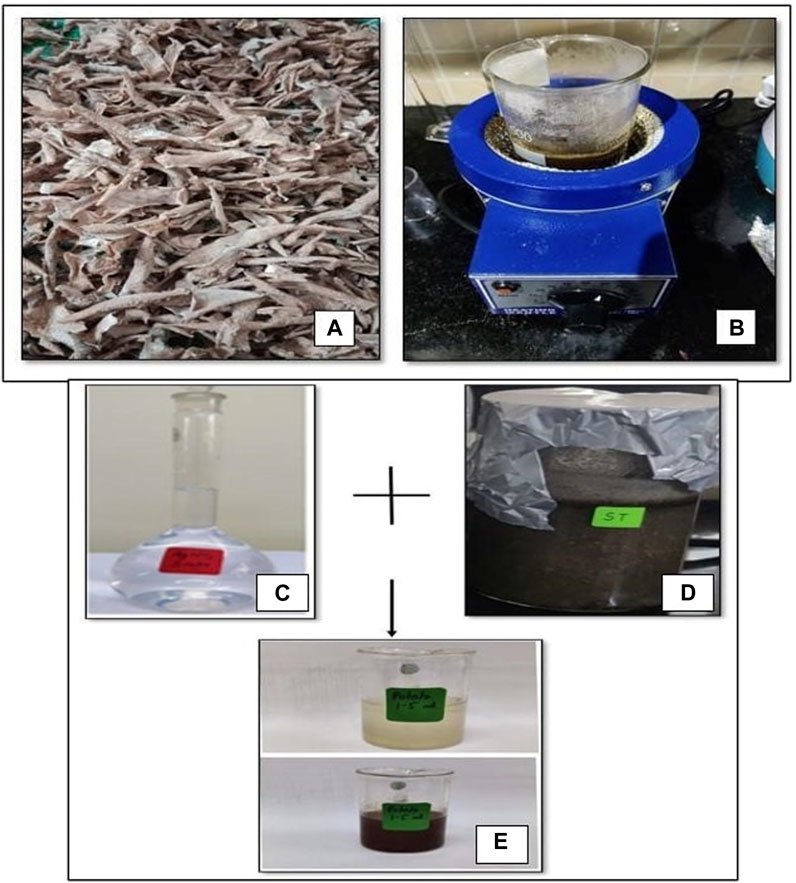
FIGURE 1. Steps of processing of potato peels and the synthesis of silver nanoparticles. (A) Dry tuber peels of Potato (Solanum tuberosum); (B) extraction of potato peel; (C) preparation of silver nanoparticles by combining 1.0 mM silver nitrate solution; (D) potato peels (Solanum tuberosum) extract and (E) color variation, as detected before and after the incubation period throughout the synthesis of silver nanoparticles.
A volume of 1 mM of silver nitrate (AgNO3) aqueous solution was prepared according to the requirement for generating AgNPs. For reducing silver to silver ions, 50 mL of aqueous solution of AgNO3 was added to 1.5 mL of peel extract. The mixture was boiled for 30 min at 65°C, followed by incubation for 24 h at room temperature. The color of the solution changed from pale yellow to dark brown (Figure 1E), which confirmed the formation of AgNPs. Before being kept in water, the obtained solutions were periodically rinsed with distilled water after centrifugation at 3,000 rpm for 10 min.
Based on color shifts, the incubated extracts of potato (Solanum tuberosum) peel demonstrated the synthesis of AgNPs.
As a validation of the fabrication of nanoparticles, the generated AgNPs from potato (Solanum tuberosum) peels were studied after 24 h for the optical dimensions using a UV-visible spectrometer (Ocean Insight HR 2000+ high-resolution spectrometer). The scan was carried out with a resolution of 1 nm and a frequency range of 200–800 nm. A 1-cm quartz crystal cuvette was used to record the UV-visible spectrum, with dual purified water acting as the blank reference.
The FESEM technology was applied to examine the structural characteristics of the generated AgNPs. The technique was also used to determine the measurement, structure, and external morphology of AgNPs. The micrographs from the JSM-7001F model were obtained by field emission scanning electron microscopy. The extracted sample was gently dropped on coverslips and dried out. The sample was then sputtered with gold in order to generate the images by observing it under FESEM.
The X-ray diffraction technique was cast off to analyze the crystal assembly of metallic AgNPs. The Rigaku SmartLab X-ray diffractometer was used to evaluate the XRD pattern. The diffraction intensities between the 20 and 800 2θ angle regions were studied.
With the support of Shimadzu IRSpirit and ATR-IR Spectroscopic methods, the influence of functional groups on the stabilization (reduction) and synthesis of silver nanoparticles obtained from the potato peel extracts was analyzed.
The test materials used for the antibacterial activity of AgNPs were potato peels (Solanum tuberosum). For the positive control, the antibiotic ciprofloxacin (powder) was purchased from Sigma-Aldrich. Cation-adjusted Mueller–Hinton agar powder M173 was obtained from HiMedia.
Appropriate bacterial strains of Escherichia coli (25922) and Staphylococcus aureus (25923) from the American Type Culture Collection (ATCC) were employed for the antibacterial evaluation.
The bacteria were separately cultivated overnight in an incubator shaker (200 rpm) at 37°C for the exponential growth stage in freshly prepared cation-adjusted Mueller–Hinton broth (CaMHB). The Gram staining technique was used to detect cultures after incubation, and its optical density (OD) was modified to obtain 107 CFU/mL. By combining 3.2 mg of the test substance in 1 mL of DMSO, an ideal master stock (MS) solution of 3,200 mg/mL was obtained. The MS 3.2 mg/mL was diluted two-fold to get the concentrations of 32, 16, 8, and 4 μg/mL. The disc diffusion method was performed. For the negative and positive controls, 10 μL of the vehicle and ciprofloxacin concentrations of 0.125 μg/mL, 0.25 μg/mL, and 0.5 μg/mL were added to pre-labeled respective discs. Discs were made of test compounds, and discs made of vehicle and ciprofloxacin were placed onto the MHA plates with the lawn of E. coli and S. aureus. The plates were then incubated at 37°C for ∼24 h. After incubation, plates were examined for zones, and zone diameter (mm) was estimated. Finally, the zone of inhibition (ZOI) was measured and recorded.
The industrial wastewater was collected from the Ecosystem Ecology Research Unit, Department of Environmental Science, Central University of South Bihar, Gaya, Bihar. To eliminate the macroparticles and other suspended waste materials, the obtained samples of water were then passed through Whatman paper filters (No. 1). The filtered samples were stored at 10°C.
A measure of 100 mL of the filtered wastewater was treated with 10 mg of synthesized AgNPs for 6 h under laboratory conditions. The wastewater samples were then analyzed to study various physio-chemical parameters like pH, total dissolved solid (TDS), ammonia, biochemical oxygen demand (BOD), and chemical oxygen demand (COD). The pH of the water samples was tested using a Meter Systronics—361 pH meter. Total dissolved solids were estimated by following IS: 3025 (Part 16). Chemical oxygen demand (COD) was estimated by the titrimetric method. Biological oxygen demand was measured with an aid of blank and sample burette readings and a known concentration of the standard solution. The ammonia content in the wastewater (before and after treatment) was tested using the Compact Ammonia Duo (portable turbidity and ammonia combined kit) obtained from Palintest-Water Analysis Technologies.
Differences in water quality parameters of wastewater before and after treatment were tested through One way ANOVA, whereas the post-incubation zone of inhibitions (diameter mm) was tested using the Kruskal–Wallis test. All the data analyses were carried out using Microsoft Excel and SPSS-26.
Nanoparticles were generated by compounding 50 mL of 1 mM silver nitrate solution with 1.5 mL of aqueous potato (Solanum tuberosum) peel extract. The shift in color demonstrated that a decrease in silver ions was responsible for the synthesis of AgNPs.
The point of origin of the particle surface plasmon resonance absorption was determined using UV-visible spectroscopy. The UV-vis spectra of the biosynthesized nanoparticles at 1 mM exhibit significant points in the visible array ranging from 200 to 800 nm for the potato (Solanum tuberosum) peel extract, confirming the formation of the silver nanoparticles. The extreme captivation peak for potato (Solanum tuberosum) was observed at 441 nm (Figure 2), which also occurred as a result of the excitation caused by plasmon resonance in the nanostructures of a particular color (light to dark brown).
The surface characteristic, properties, and structure of the biosynthesized AgNPs were examined by field emission scanning electron microscopy (FESEM). The resulting FESEM demonstrates that spherical AgNPs were seen without any aggregation as shown in Figure 3. The FESEM images depict the abundance of AgNPs produced by the peel extract. In the case of potato peels, the AgNP dispersion was excellent. In addition, the size of the nanoparticles, in accordance with their distribution, ranged widely from 30 to 50 nm. The investigational parameters and the premeditated reducing/capping agent affected the dimensions, form, and dispensability of NPs (Sharma et al., 2020). The uniform tentative parameters were maintained in the current study.
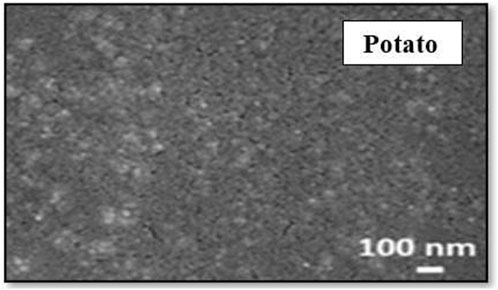
FIGURE 3. Field emission scanning electron microscopy (FESEM) of synthesized silver nanoparticles for potato (Solanum tuberosum) peels.
The X-ray diffraction (XRD) investigations of the generated AgNPs are shown in Figure 4. Investigating the XRD arrangement is an excellent procedure for assisting the synthesis of nanoparticles as it provides data on physical arrangements and the breach between the particles. In the case of potato peels, the peaks were observed at 38.22°, 43.300, and 76.500, which correspond to various (111), (200), and (311) Bragg’s reflections. These values were consistent with JCPDS. These findings suggested that face-centered (FCC) and cubic-structured silver nanoparticles are fabricated using green manufacturing standards. The crystallite size was calculated using Scherrer’s equation formula, D = kλ/β cos, which was used to regulate the size of the silver nanoparticles. The crystallite size of AgNPs ranged from 20 to 70 nm on average. The XRD patterns were a reliable vast amount of information relating to the cubic arrangement of silver nanoparticles demonstrating the production process.
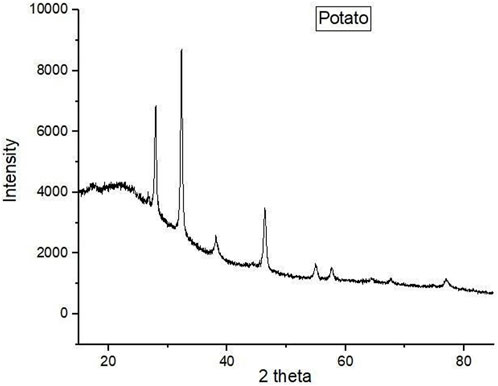
FIGURE 4. X-ray diffraction (XRD) characterization of silver nanoparticles generated from potato peels (Solanum tuberosum).
ATR-IR spectroscopy analysis was used to identify the functional groups of silver nanoparticles produced through biosynthesis that are primarily responsible for converting Ag+ to Ag0 (Figure 5). The ATR-IR spectra of potato peels displayed maxima at approximately 1,318 cm−1, 1,644 cm−1, 1,969 cm−1, 2,198 cm−1, and 3,305 cm−1 that can be attributed to various groups, such as sulfoxides and sulfates (S=O). Alkenes (C = C) and amide (C=O) revealed a peak at 1,644 cm−1, while allenes (X = C = Y), ketenes, and isocyanates showed vibration at 1,969 cm−1. The band at 2,198 cm−1 corresponded to the alkyne group, whereas the band at 3,305 cm−1 corresponded to alcohol (OH) and phenol groups.
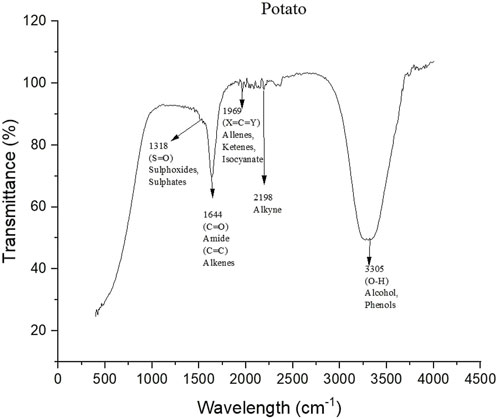
FIGURE 5. Attenuated total reflection-infrared spectroscopy (ATR-IR) spectra from 400 cm−1 to 4000 cm−1 of silver nanoparticles generated from potato peels.
The disc diffusion method was used to assess the antibacterial activities of silver nanoparticles against Gram-negative bacteria Escherichia coli (E. coli) (ATCC 25922) and Gram-positive bacteria Staphylococcus aureus (S. aureus) (ATCC 25923). The silver nanocomposites synthesized in the present study showed antibacterial activity on both types of bacteria (Figure 6). Many previous studies asserted that a significant portion of this result can be attributed to the strong affinity of silver for sulfur in bacterial thiol proteins (Stewart et al., 2012).
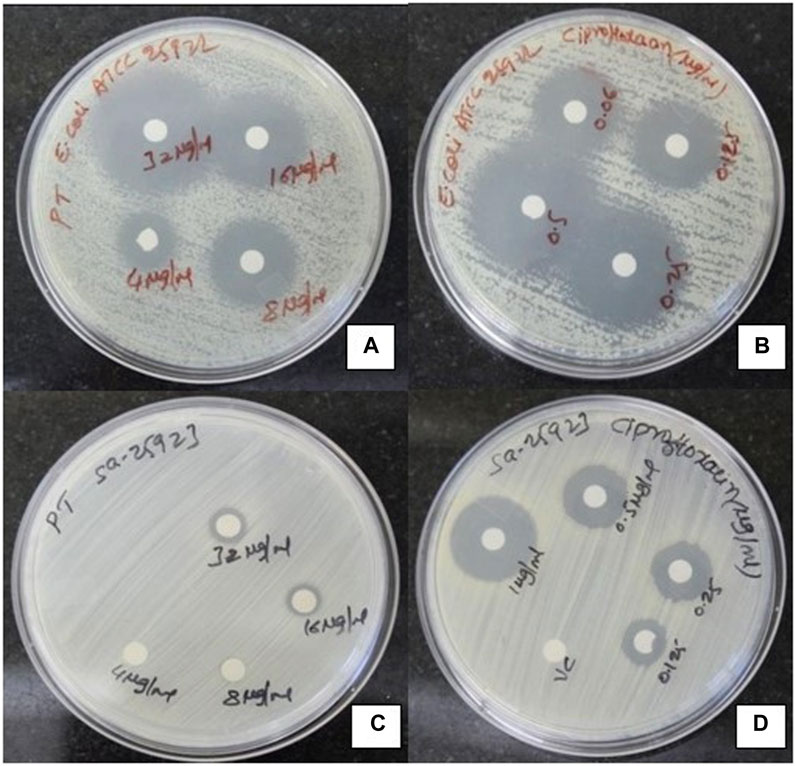
FIGURE 6. Antibacterial activity of AgNPs against Escherichia coli (E. coli) (A) and Staphylococcus aureus (S. aureus) (B) with positive control ciprofloxacin (C, D).
Figure 7 indicates that AgNPs worked better against E. coli than S. aureus. The diameters of the inhibitory zones for both bacterial species are shown in Table 1. The activity of AgNPs against E. coli displayed a substantially larger zone of inhibition than S. aureus (Figure 7). The potato (Solanum tuberosum) peel-generated AgNPs showed concentration-dependent ZOI against E. coli (ATCC 25922), and the diameters of ZOI at various concentrations of 32, 16, 8, and 4 μg/mL were 67.3 mm, 39.3 mm, 23.4 mm, and 15.3 mm, respectively. The diameters of concentration-dependent ZOI against S. aureus (ATCC 25923) at concentrations of 32 and 16 μg/mL were 13.2 mm and 6.3 mm, respectively. ZOI of antibiotic ciprofloxacin against E. coli (ATCC 25922) showed concentration-dependent ZOI, and the diameters were 41.8 mm, 58.4 mm, and 72.4 mm at various concentrations of 0.125 μg/mL, 0.25 μg/mL, and 0.5 μg/mL, respectively. ZOI of ciprofloxacin against S. aureus (ATCC 25923) showed concentration-dependent ZOI, and the diameters were 14.5 mm, 21.3 mm, and 27.5 mm at concentrations of 0.125 μg/mL, 0.25 μg/mL, and 0.5 μg/mL, respectively. Therefore, this study indicated that Gram-negative bacteria like E. coli have been found to be more susceptible to AgNPs than Gram-positive bacteria such as S. aureus. Previous investigations also evaluated the substantial antimicrobial potential of peel-based silver nanoparticles against E. coli (Haniff Nisha et al., 2015; Sharma et al., 2016; Yadav et al., 2017; Baran et al., 2021).
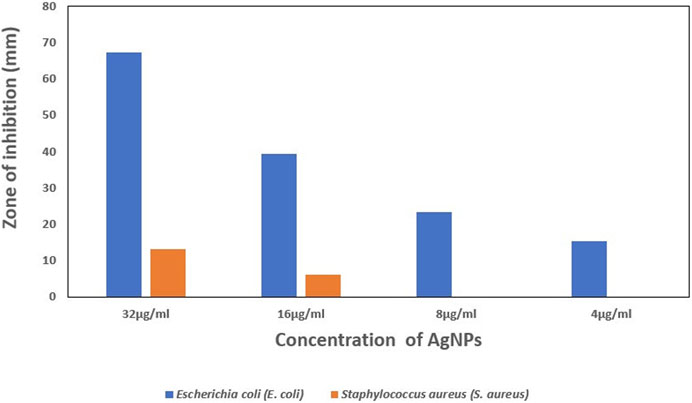
FIGURE 7. The Zone of inhibition of Escherichia coli and Staphylococcus aureus, as a function of AgNPs concentration.

TABLE 1. ZOI of potato (Solanum tuberosum) and ciprofloxacin against Escherichia coli and Staphylococcus aureus.
The values of important water quality parameters of wastewater before and after treatment with AgNPs are provided in Table 2. Post-application of AgNPs, the final concentration of TDS, COD, BOD, and ammonia was significantly reduced. Figure 8 shows a summary of potato-derived AgNP-mediated reduction in pollution. Silver nanoparticles tend to reduce BOD from 46 mg/L to 12 mg/L and COD from 388 mg/L to 66 mg/L when added to wastewater. The removal efficiency was thus determined to be 73.91% for BOD, and 82.98% for COD (Figure 8).

TABLE 2. Values of water quality parameters of wastewater before and after treatment with green-synthesized silver nanoparticles from the potato (Solanum tuberosum) peels.
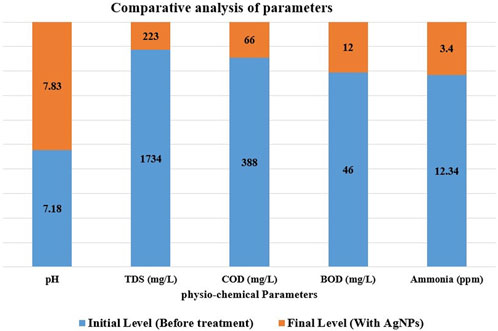
FIGURE 8. The physicochemical parameters of wastes water before and after treatment through potato-peels derived AgNPs.
The generation of silver nanoparticles (AgNPs) utilizing kitchen waste is referred to as sustainable nanoscience technology, which has the potential to be environmentally benign. AgNPs exhibit a yellowish-brown appearance in an aqueous solution because of the plasmon resonance activity (Pudake et al., 2019; Xing et al., 2021; Deepa and Dhanker, 2022). Several researchers have gradually put forth a multitude of excellent methods for synthesizing nanomaterials (Pericival et al., 2007; Mata et al., 2009; Yadav et al., 2017; Yadav et al., 2018; Xing et al., 2021). Biopolymers make a substantial contribution toward the reduction of nanoparticles (Sharma et al., 2020; Murugesan et al., 2023). Vegetable peel extracts used to generate AgNPs contain phytochemicals (Azam et al., 2012; Arunachalam et al., 2013). However, additional extensive study is required to yield results that are more likely to be realistic and advantageous for the advancement of mankind and a protected environment. The antibacterial characteristics of AgNPs synthesized from leftover vegetable and fruit peels against both kinds of bacterial strains (Gram-positive and Gram-negative) have been reported in many studies (Tripathi and Sirohi, 2016).
The inclusion of peptide groups serves as a capping agent, improving the stabilization of AgNPs (Rodriguez et al., 2013). Utilizing the ATR-IR study, the functional groups of green-synthesized AgNPs, which are primarily accountable for the reduction of Ag+ to Ag0, were determined. The ATR-IR spectra of potato peel exhibited maxima for various groups, such as amide (C = O). Rendering to the consequences of the ATR-IR analysis, it is likely that the phytochemicals as well as certain proteins in potato peel extracts are responsible for stabilization and capping of the nanomaterials. Potato peels contain a considerable number of active components, such as cellulose, vitamins, and phenols (Rajarathinam et al., 2014; Gebrechristos et al., 2020; Rodríguez-Martínez et al., 2021). These naturally occurring substances are comprehensively recognized as bioactive substances with considerable antioxidant and antibacterial properties (Akyol et al., 2016; Yadav et al., 2017; Gebrechristos et al., 2020; Joshi et al., 2020; Rodríguez-Martínez et al., 2021).
Silver nanoparticles are considered to have antibacterial properties (Yadav et al., 2017; Baran et al., 2021). AgNPs were utilized in a variety of medical applications as an antibacterial agent (El-Rafie et al., 2012; Ibrahim, 2015). The present study convincingly suggested that AgNPs synthesized from potato peels have antibacterial potential against both Gram-positive and Gram-negative bacteria, and this can be considered an additional source of income from potato wastes. It has been revealed that AgNPs generated from other parts of potatoes, such as peels, tuber, and starch, are cytotoxic to Gram-negative bacteria (Vigneshwaran et al., 2007; Yadav et al., 2017; Xing et al., 2021; Wasilewska et al., 2023). The present study indicated that Gram-negative bacteria like E. coli have been found to be more sensitive to potato peel-generated silver nanoparticles than Gram-positive bacteria such as S. aureus. Wasilewska et al. (2023) explicated the synthesis of plant-mediated AgNPs using various plant extracts, including potato tuber extract, and assessed their antimicrobial properties against Staphylococcus aureus, Bacillus cereus, Escherichia coli, and Candida krusei. Their study demonstrated that AgNPs synthesized from potato extract have the strongest antimicrobial effects among white onion, radish, garlic, red pepper, orange, and apple. Apart from the nanoparticle’s various characteristics, antibacterial properties against Gram-negative bacteria such as E. coli and Gram-positive bacteria such as S. aureus showed that potato peel extract-based nanomaterials can function as strong antimicrobial agents. Moreover, another investigation carried out by Wolny-Koładka et al. (2022) highlighted the potato peel- and edible parsley stem extract-mediated synthesis of silver nanoparticles. By using a non-toxic base obtained from plant waste biomass, the research conducted in this study supports the idea that nano-silver with good physicochemical properties has potent antimicrobial properties against bacteria like E. coli and S. aureus isolated from surfaces of public utilities. Pirathiba and Dayananda (2021) conducted the biosynthesis of AgNPs by reducing and capping potato peels. It was observed that both E. coli and Streptococcus mutans bacterial species were sensitive to the ecologically produced silver nanoparticles. In our study, wastewater was treated with AgNPs. We found that the final concentration of TDS, COD, BOD, and ammonia was much lower after the application of AgNPs, and the pH range increased. When added to wastewater, silver nanoparticles typically reduced BOD from 46 mg/L to 12 mg/L and COD from 388 mg/L to 66 mg/L. Hence, it was established that the removal efficiency was 73.91% for BOD, and 82.98% for COD. This showed that green-synthesized AgNPs from potato peels have a greater efficiency to purify wastewater.
For economic expansion and alleviating poverty, optimum utilization of food wastes needs to be explored in the light of Sustainable Development Goals 2030. The current research established an ecologically acceptable method of generating AgNPs from potato peels from leftover kitchen wastes, which are considered zero value materials. Potato peels were utilized to generate AgNPs with a size of nearly 20–60 nm. Peels from kitchen leftovers serve as reductants in this context. The UV-visible analysis showed the maximum spectra for AgNP biosynthesis at 441 nm for potato. The nanoparticles produced through biosynthesis were spherically symmetrical according to the FESEM micrograph image analysis. To identify potential functional groups that are involved in the formation of nanoparticles, an ATR-IR investigation was conducted. The peel extract contains phytochemicals and bioactive compounds that may contribute to the production, capping, and stability of the nanoparticles. From the present results, we conclude that potato peel-derived AgNPs have excellent antibacterial properties. The comparative effective bactericidal activity of AgNPs can be further verified by broadening this research to examine a wider variety of microbial strains. Food waste is a serious problem that keeps getting worse. Peel and leaf parts of potatoes are wastes that can be utilized to generate AgNPs which have the potential to provide a cost-effective and ecologically advantageous alternative for wastewater treatment and anti-pathogenic agents acting as a linkage between agriculture and industries. AgNPs are employed in a diverse range of industries. The synthesis of AgNPs from potato wastes will support the management of food waste, which in turn will help resolve environmental issues and minimize waste, hence boosting the agrarian economy in developing countries and opening an alternative path for sustainable economic growth. This work will facilitate an environmentally friendly and cost-effective route to material production.
The original contributions presented in the study are included in the article/Supplementary Materials, further inquiries can be directed to the corresponding author.
D (1st author) wrote the first draft of the manuscript. The concept was proposed by RD. The content of the document was overseen and expertly edited by RD. The paper underwent a thorough review and editing by RK, SSK, K (5th author), and SG. All authors contributed to the article and approved the submitted version.
The authors express their gratitude to GD Goenka University for supporting the first author to pursue a doctoral study. The authors express their special thanks to the lab members, Ecosystem Ecology Research Unit, Department of Environmental Science, Central University of South Bihar, Gaya, Bihar, for their constructive support and suggestions as research experts.
The authors declare that the research was conducted in the absence of any commercial or financial relationships that could be construed as a potential conflict of interest.
All claims expressed in this article are solely those of the authors and do not necessarily represent those of their affiliated organizations, or those of the publisher, the editors, and the reviewers. Any product that may be evaluated in this article, or claim that may be made by its manufacturer, is not guaranteed or endorsed by the publisher.
Akyol, H., Riciputi, Y., Capanoglu, E., Caboni, M., and Verardo, V. (2016). Phenolic compounds in the potato and its byproducts: an overview. Int. J. Mol. Sci. 17 (6), 835. doi:10.3390/ijms17060835
Alharthi, F. A., Alghamdi, A. A., Al-Zaqri, N., Alanazi, H. S., Alsyahi, A. A., Marghany, A. E., et al. (2020). Facile one-pot green synthesis of Ag–ZnO nanocomposites using potato peel and their AG concentration dependent photocatalytic properties. Sci. Rep. 10 (1), 20229. doi:10.1038/s41598-020-77426-y
Annu, A., Ahmed, S., Kaur, G., Sharma, P., Singh, S., and Ikram, S. (2018). Fruit waste (peel) as bio-reductant to synthesize silver nanoparticles with antimicrobial, antioxidant, and cytotoxic activities. J. Appl. Biomed. 16 (3), 221–231. doi:10.1016/j.jab.2018.02.002
Arunachalam, K., Annamalai, S., and Hari., S. (2013). One-step green synthesis and characterization of leaf extract-mediated biocompatible silver and gold nanoparticles from Memecylon umbellatum. Int. J. Nanomedicine 2013, 1307. doi:10.2147/ijn.s36670
Azam, A., Ahmed, O., Khan, H., and Memic, A. (2012). Antimicrobial activity of metal oxide nanoparticles against gram-positive and gram-negative bacteria: a comparative study. Int. J. Nanomedicine 2012, 6003. doi:10.2147/IJN.S35347
Baran, A., Keskin, C., Baran, M. F., Huseynova, I., Khalilov, R., Eftekhari, A., et al. (2021). Ecofriendly synthesis of silver nanoparticles using Ananas comosus fruit peels: anticancer and antimicrobial activities. Bioinorganic Chem. Appl. 2021, 1–8. doi:10.1155/2021/2058149
Bhattarai, B., Zaker, Y., and Bigioni, T. (2018). Green synthesis of gold and silver nanoparticles: challenges and opportunities. Curr. Opin. Green Sustain. Chem. 12, 91–100. doi:10.1016/j.cogsc.2018.06.007
Buazar, F., Baghlani-Nejazd, M. H., Badri, M., Kashisaz, M., Khaledi-Nasab, A., and Kroushawi, F. (2016). Facile one-pot phytosynthesis of magnetic nanoparticles using potato extract and their catalytic activity. Starch - Stärke 68 (7–8), 796–804. doi:10.1002/star.201500347
Buazar, F., Bavi, M., Kroushawi, F., Halvani, M., Khaledi-Nasab, A., and Hossieni, S. A. (2015). Potato extract as reducing agent and stabiliser in a facile green one-step synthesis of ZnO nanoparticles. J. Exp. Nanosci. 11 (3), 175–184. doi:10.1080/17458080.2015.1039610
Castillo-López, D. N., and Pal, U. (2014). Green synthesis of Au nanoparticles using potato extract: stability and growth mechanism. J. Nanoparticle Res. 16 (8), 2571. doi:10.1007/s11051-014-2571-3
Chaudhry, Q., Scotter, M., Blackburn, J., Ross, B., Boxall, A., Castle, L., et al. (2008). Applications and implications of nanotechnologies for the food sector. Food Addit. Contam. Part A 25 (3), 241–258. doi:10.1080/02652030701744538
Christensen, M. L., Keiding, K., Nielsen, P. H., and Jørgensen, M. K. (2015). Dewatering in biological wastewater treatment: A review. Water Res. 82, 14–24. doi:10.1016/j.watres.2015.04.019
Chung, I., Park, I., Seung-Hyun, K., Thiruvengadam, M., and Rajakumar, G. (2016). Plant-mediated synthesis of silver nanoparticles: their characteristic properties and therapeutic applications. Nanoscale Res. Lett. 11 (1), 40. doi:10.1186/s11671-016-1257-4
Deepa, A. F., Amirul Islam, M., and Dhanker, R. (2022). Green synthesis of silver nanoparticles from vegetable waste of pea pisum sativum and bottle gourd Lagenaria Siceraria: characterization and antibacterial properties. Front. Environ. Sci. 10, 941554. doi:10.3389/fenvs.2022.941554
Deepa , , and Dhanker, R. (2022). “Nanoparticles Synthesis from Kitchen Waste: opportunities, Challenges, and Future Prospects” in Environmental Management Technologies. Editor P. Chowdhary, V. Kumar, S. Kumar, and V. Hare (Boca Raton: CRC Press) 384.
Dhanker, R., Hussain, T., Tyagi, P., Singh, K. J., and Kamble, S. S. (2021). The emerging trend of bio-engineering approaches for microbial nanomaterial synthesis and its applications. Front. Microbiol. 12, 638003. doi:10.3389/fmicb.2021.638003
Dhanker, R., Rawat, S., Chandna, V., DeepaKumar, R., Das, S., Sharma, A., et al. (2022). Recovery of silver nanoparticles and management of food wastes: obstacles and opportunities. Environ. Adv. 9, 100303. doi:10.1016/j.envadv.2022.100303
El-Rafie, M., Shaheen, T., Mohamed, A., and Hebeish, A. (2012). Bio-synthesis and applications of silver nanoparticles onto cotton fabrics. Carbohydr. Polym. 90 (2), 915–920. doi:10.1016/j.carbpol.2012.06.020
Gebrechristos, H. Y., Ma, X., Xiao, F., He, Y., Zheng, S., Oyungerel, G., et al. (2020). Potato Peel extracts as an antimicrobial and potential antioxidant in active edible film. Food Sci. Nutr. 8 (12), 6338–6345. doi:10.1002/fsn3.1119
Ghosh, P. R., Sharma, S. B., Haigh, Y. T., Barbara Evers, A. L., and Ho, G. (2015). An overview of food loss and waste: why does it matter? COSMOS 11, 89–103. doi:10.1142/s0219607715500068
Gorinstein, S., Martin-Belloso, O., Park, Y., Haruenkit, R., Lojek, A., Ĉiž, M., et al. (2001). Comparison of some biochemical characteristics of different citrus fruits. Food Chem. 74 (3), 309–315. doi:10.1016/s0308-8146(01)00157-1
Gustavsson, J., Cederberg, C., Sonesson, U., van Otterdijk, R., and Meybeck, A. (2011). Global food losses and food waste: Extent, causes and prevention. Rome, Italy: Food and Agriculture Organisation of the United Nations.
Haniff Nisha, M., Tamileswari, R., and Jesurani, S. (2015). Analysis of anti-bacterial activity of silver nanoparticles from pomegranate (Punica granatum) seed and peel extracts. Int. J. Eng. Res. 4 (04), 1104. doi:10.17577/ijertv4is041104
Hasanin, M. S. (2021). Simple, economic, ecofriendly method to extract starch nanoparticles from potato peel waste for biological applications. Starch - Stärke 73 (9–10), 2100055. doi:10.1002/star.202100055
Ibrahim, H. M. M. (2015). Green synthesis and characterization of silver nanoparticles using banana peel extract and their antimicrobial activity against representative microorganisms. J. Radiat. Res. Appl. Sci. 8 (3), 265–275. doi:10.1016/j.jrras.2015.01.007
Joshi, N. C., Chhabra, J., Kaur, K., and Thakur, A. (2020). Potato tuber extract based synthesis, characterisation, and antibacterial activity of silver nanoparticles. Octa J. Biosci. 8 (1), 17–20.
Kim, H., Kim, H., Monadic, A., Gyawali, R., Ahn, K., and Cho, S. (2012). Induction of apoptosis by ethanolic extract of mango peel and comparative analysis of the chemical constitutes of mango peel and flesh. Food Chem. 133 (2), 416–422. doi:10.1016/j.foodchem.2012.01.053
Kokila, T., Ramesh, P., and Geetha, D. (2015). Biosynthesis of silver nanoparticles from cavendish banana peel extract and its antibacterial and free radical scavenging assay: a novel biological approach. Appl. Nanosci. 5 (8), 911–920. doi:10.1007/s13204-015-0401-2
Lara, H., Ayala-Núñez, N., Ixtepan Turrent, L., and Rodríguez Padilla, C. (2009). Bactericidal effect of silver nanoparticles against multidrug-resistant bacteria. World J. Microbiol. Biotechnol. 26 (4), 615–621. doi:10.1007/s11274-009-0211-3
Lateef, A., Azeez, M. A., Asafa, T. B., Yekeen, T. A., Akinboro, A., Oladipo, I. C., et al. (2016). Biogenic synthesis of silver nanoparticles using a pod extract of colanitida: antibacterial and antioxidant activities and application as a paint additive. J. Taibah Univ. Sci. 10 (4), 551–562. doi:10.1016/j.jtusci.2015.10.010
Mata, Y. N., Torres, E., Blázquez, M. L., Ballester, A., González, F., and Muñoz, J. A. (2009). Gold (III) biosorption and bioreduction with the Brown alga Fucus vesiculosus. J. Hazard. Mater. 166 (2–3), 612–618. doi:10.1016/j.jhazmat.2008.11.064
Murugesan, A. K., Murugesan, V., Thirunavoukkarasu, M., and Gunasagaran, K. S. (2023). The conversion of municipal wastes process enhances the environmentally friendly and novel PFE-AgNPs into potential anti-bacterial and anticancer activities. Biomass Convers. Biorefinery 23, 4144–4146. doi:10.1007/s13399-023-04144-6
Patra, J. K., and Baek, K. H. (2016). Green synthesis of silver chloride nanoparticles using Prunus persica L. outer peel extract and investigation of antibacterial, anticandidal, antioxidant potential. Green Chem. Lett. Rev. 9 (2), 132–142. doi:10.1080/17518253.2016.1192692
Patra, J. K., Das, G., and Shin, H.-S. (2019). Facile green biosynthesis of silver nanoparticles using pisum sativum L. outer peel aqueous extract and its antidiabetic, cytotoxicity, antioxidant, and antibacterial activity. Int. J. Nanomedicine 14, 6679–6690. doi:10.2147/ijn.s212614
Percival, S., Bowler, P., and Dolman, J. (2007). Antimicrobial activity of silver-containing dressings on wound microorganisms using an in vitro biofilm model. Int. Wound J. 4 (2), 186–191. doi:10.1111/j.1742-481x.2007.00296.x
Pirathiba, S., and Dayananda, B. S. (2021). Potato peel waste as reductant for the biogenesis of gold and silver ultrafine particles. Mater. Today Proc. 42, 1084–1090. doi:10.1016/j.matpr.2020.12.266
Pudake, R. N., Chauhan, N., and Kole, C. (2019). Nanoscience for sustainable agriculture. Berlin, Germany: Springer International Publishing.
Rajarathinam, M., Dhanapal, D., Morukattu, G., Joseph, S., and Thangavelu, K. (2014). Imparting potential antibacterial and antifungal activities to water based interior paint using nanoparticles of silver as an additive—an ecofriendly approach. Adv. Sci. Eng. Med. 6 (6), 676–682. doi:10.1166/asem.2014.1550
Rodriguez, P., Harada, T., Christian, D., Pantano, D., Tsai, R., and Discher, D. (2013). Minimal "self" peptides that inhibit phagocytic clearance and enhance delivery of nanoparticles. Science 339 (6122), 971–975. doi:10.1126/science.1229568
Rodríguez-Martínez, B., Gullón, B., and Yáñez, R. (2021). Identification and recovery of valuable bioactive compounds from potato peels: a comprehensive review. Antioxidants 10 (10), 1630. doi:10.3390/antiox10101630
Sharma, B., Singh, I., Bajar, S., Gupta, S., Gautam, H., and Kumar, P. (2020). Biogenic silver nanoparticles: evaluation of their biological and catalytic potential. Indian J. Microbiol. 60 (4), 468–474. doi:10.1007/s12088-020-00889-0
Sharma, K., Kaushik, S., and Jyoti, A. (2016). Green synthesis of silver nanoparticles by using waste vegetable peel and its antibacterial activities. J. Pharm. Sci. Res. 8 (5), 313–316.
Shittu, O., Gara, T. Y., and Onyinye, I. (2022). Removal of contaminant in electroplating waste water and its toxic effect using biosynthesized silver nanoparticles. SN Apllied Sci. 1, 422. doi:10.21203/rs.3.rs-1415422/v1
Soong, Y., and Barlow, P. (2004). Antioxidant activity and phenolic content of selected fruit seeds. Food Chem. 88 (3), 411–417. doi:10.1016/j.foodchem.2004.02.003
Stewart, A., Zheng, S., McCourt, M. R., and Bell, S. E. J. (2012). Controlling Assembly of mixed thiol monolayers on silver nanoparticles to tune their surface properties. ACS Nano 6 (5), 3718–3726. doi:10.1021/nn300629z
Tavakoli, F., Salavati-Niasari, M., badiei, A., and Mohandes, F. (2015). Green synthesis and characterization of graphene nanosheets. Mater. Res. Bull. 63, 51–57. doi:10.1016/j.materresbull.2014.11.045
Tripathi, A., and Sirohi, R. (2016). Antimicrobial activities of silver nanoparticles synthesized from peel of fruits and vegetables. Biol. Insights 1, 29–34.
Vigneshwaran, N., Ashtaputre, N., Varadarajan, P., Nachane, R., Paralikar, K., and Balasubramanya, R. (2007). Biological synthesis of silver nanoparticles using the fungus Aspergillus flavus. Mater. Lett. 61 (6), 1413–1418. doi:10.1016/j.matlet.2006.07.042
Wasilewska, A., Klekotka, U., Zambrzycka, M., Zambrowski, G., Święcicka, I., and Kalska-Szostko, B. (2023). Physico-chemical properties and antimicrobial activity of silver nanoparticles fabricated by Green Synthesis. Food Chem. 400, 133960. doi:10.1016/j.foodchem.2022.133960
Wolny-Koładka, K., Malina, D., Suder, A., Pluta, K., and Wzorek, Z. (2022). Bio-based synthesis of silver nanoparticles from waste agricultural biomass and its antimicrobial activity. Processes 10 (2), 389. doi:10.3390/pr10020389
Xing, Y., Liao, X., Liu, X., Li, W., Huang, R., Tang, J., et al. (2021). Characterization and antimicrobial activity of silver nanoparticles synthesized with the peel extract of mango. Materials 14 (19), 5878. doi:10.3390/ma14195878
Yadav, L., Tripathi, R. M., Prasad, R., Pudake, R. N., and Mittal, J. (2017). Antibacterial activity of Cu nanoparticles against E. Coli, Staphylococcus aureus and pseudomonas aeruginosa. Nano Biomed. Eng. 9 (1), 9–14. doi:10.5101/nbe.v9i1.p9-14
Yadav, S. G., Patil, S. H., Patel, P., Nair, V., Khan, S., Kakkar, S., et al. (2018). Green synthesis of silver nanoparticles from plant sources and evaluation of their antimicrobial activity. Int. J. Sci. Res. Sci. Eng. Technol. 5 (4), 133–139.
Keywords: vegetable peels, silver metal nanoparticles, characterization, antibacterial properties, wastewater treatment
Citation: Deepa , Dhanker R, Kumar R, Kamble SS, Kamakshi and Goyal S (2023) Biosynthesis and characterization of silver nanoparticles generated from peels of Solanum tuberosum (potato) and their antibacterial and wastewater treatment potential. Front. Nanotechnol. 5:1213160. doi: 10.3389/fnano.2023.1213160
Received: 27 April 2023; Accepted: 31 May 2023;
Published: 15 August 2023.
Edited by:
Ramesh Namdeo Pudake, Amity University, IndiaReviewed by:
Arul Kumar Murugesan, Bharathidasan University, IndiaCopyright © 2023 Deepa, Dhanker, Kumar, Kamble, Kamakshi and Goyal. This is an open-access article distributed under the terms of the Creative Commons Attribution License (CC BY). The use, distribution or reproduction in other forums is permitted, provided the original author(s) and the copyright owner(s) are credited and that the original publication in this journal is cited, in accordance with accepted academic practice. No use, distribution or reproduction is permitted which does not comply with these terms.
*Correspondence: Raunak Dhanker, cmF1bmFrLmRoYW5rZXJAZ2RndS5vcmc=; Shashank S. Kamble, c2hhc2hhbmtjYW1AZ21haWwuY29t
Disclaimer: All claims expressed in this article are solely those of the authors and do not necessarily represent those of their affiliated organizations, or those of the publisher, the editors and the reviewers. Any product that may be evaluated in this article or claim that may be made by its manufacturer is not guaranteed or endorsed by the publisher.
Research integrity at Frontiers

Learn more about the work of our research integrity team to safeguard the quality of each article we publish.